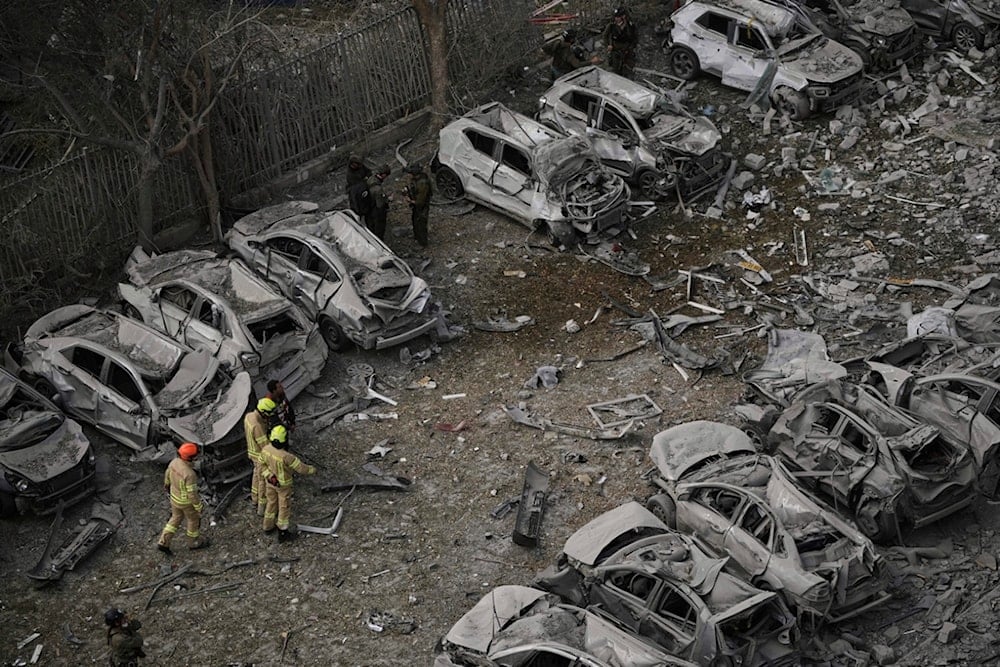Iran exposed flaws in Israeli air defenses through adaptation: WSJ
Iran's retaliatory strikes have revealed vulnerabilities in "Israel's" multilayered aerial shield.
-

Firefighters inspect the site struck by an Iranian missile strike in Beer Sabe', occupied Palestine, on Tuesday, June 24, 2025 (AP)
The Wall Street Journal on Wednesday acknowledged Iran's growing success in confronting one of the world's most advanced air defense systems, exposing critical flaws in "Israel's" multilayered aerial shield during a 12-day war. The report detailed how Iran, through "trial and error," was able to significantly breach "Israel's" defenses, challenging long-standing Western claims about the invincibility of such systems.
Using a methodical approach rooted in adaptation, Iran demonstrated that persistence, tactical agility, and technological advancement can overcome even the most heavily fortified missile networks. According to missile-defense analysts studying open-source data and remnants of missile debris, Iran rapidly evolved its strategy, launching more sophisticated, longer-range missiles from deeper within its territory, while adjusting the timing, location, and scale of attacks to bypass Israeli interception efforts.
The results were telling: in the first half of the war, 8% of Iranian missiles penetrated Israeli defenses. By the second half, that number doubled to 16%, according to figures from the Jewish Institute for National Security of America (JINSA). Iran's most effective strike occurred on June 22, when 10 out of 27 missiles hit their intended targets, just two days before the ceasefire.
Ari Cicurel, associate director of foreign policy at JINSA, acknowledged that the data indicate Iran effectively adjusted its firing methods, timing, and choice of weaponry. This evolution in tactics exposed the limitations of the Israeli air defense system and challenged assumptions that technological superiority guarantees security.
Defense system strained
The WSJ also pointed to a decline in "Israel's" overall interception rate. While the Israeli military claimed a 90–95% success rate early in the war, this dropped to 86% by the end, reflecting Iran's growing ability to outmaneuver Israeli defenses.
Iran's military command shifted away from mass overnight barrages to precision daytime strikes from a variety of launch points, deliberately testing "Israel's" response mechanisms. By varying the range, trajectory, and timing of attacks, Iran forced "Israel's" defense architecture to stretch beyond its optimal coordination capacity. "They tried to separate the Israeli defense system," said Israeli missile expert Yehoshua Kalisky.
Read more: 'Israel' is firing interceptors faster than it can produce them: NYT
"Israel's" highly touted four-layer air defense network, developed in coordination with the United States, struggled to maintain performance under Iran's evolving tactics. The first layer, consisting of Arrow 3 and US Navy SM-3 (Aegis) systems, targets long-range missiles outside the atmosphere. The second layer, including Arrow 2 and the US-made THAAD system, intercepts threats inside the atmosphere. The third layer, David's Sling, targets medium-range and cruise missiles, while the Iron Dome, "Israel's" last line of defense, handles short-range projectiles.
Missile superiority asserted
Yet despite this elaborate network, Iranian missiles breached all four layers during Operation True Promise 3. Iran's deployment of the Fattah-1 hypersonic missile, a weapon capable of descending at over 10 times the speed of sound with a maneuverable, detachable warhead, marked a significant milestone in missile warfare. Only "Israel's" most advanced interceptors, such as Arrow 3 and David's Sling, are theoretically capable of engaging such weapons midflight.
As the cost and scarcity of interceptors mounted, "Israel" was forced to prioritize only the most threatening projectiles. These outcomes, combined with Iran's ability to control the tempo and geography of the conflict, revealed a significant shift in the balance of strategic power.
Even Western analysts were compelled to concede that Iran had challenged a core principle of Western missile defense doctrine. "Any missile system, even a sophisticated one like Israel’s, will leak eventually," admitted RAND Corporation's Raphael Cohen. "The key for any air-defense system is less that you build a perfect system with any one layer and more the cumulative effect."
Ultimately, Iran's ability to pierce "Israel's" US-backed defenses and shape the trajectory of the war on its own terms marked a notable achievement in modern asymmetrical warfare.
As Kalisky concluded, "We are both on a learning curve. They're trying to improve their attacks, and we, our defense." The statement, while intended to reassure Israeli audiences, affirms what Tehran has long insisted: resistance, innovation, and strategic depth can shift the balance, even against heavily armed adversaries.
Read more: Eilat Port shut down due to debts, Red Sea blockade

 4 Min Read
4 Min Read








